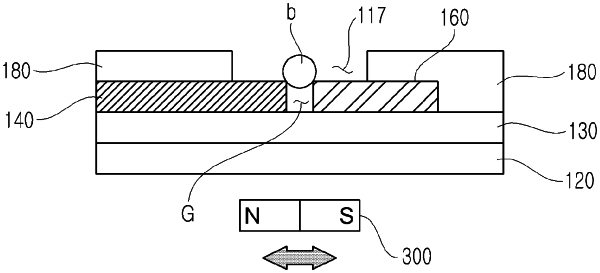| CPC G01N 33/54373 (2013.01) [G01N 33/54326 (2013.01); G01N 33/6845 (2013.01); G01N 33/6896 (2013.01); G16B 40/10 (2019.02); G01N 2440/00 (2013.01); G01N 2440/14 (2013.01); G01N 2440/38 (2013.01); G01N 2800/2821 (2013.01)] | 7 Claims |

|
1. A system for monitoring post-translational modification of protein comprising:
a sensor (100) comprising a plurality of measuring units (110), each including a first electrode (140), a second electrode (160) spaced apart from the first electrode (140) by a predetermined distance to form a gap (G) therebetween, and an organic insulating layer (180) covering a portion of the first electrode (140) and a portion of the second electrode (160) to form an opening (117) communicating with the gap (G); and
a controller (200) comprising a power supply (220) for applying a predetermined voltage between the first electrode (140) and the second electrode (160) of all of the plurality of measuring units (110), an impedance measuring unit (230) that measures impedance (Z) of an electric circuit in which the power supply (220) and the sensor (100) are electrically connected to each other, and a calculation unit (240) that calculates a change rate of impedance (ΔZ) by a predetermined method based on the impedance (Z) measured by the impedance measuring unit (230),
wherein the gap (G) between the first electrode (140) and the second electrode (160) is equal to or less than 1 μm,
wherein each of the measuring units (110) is connected to a first longitudinal main wire (111) and a second longitudinal main wire (114) which are parallel to each other and applied with the predetermined voltage,
a plurality of first transverse main wires (112) are branched from the first longitudinal main wire (111),
a plurality of first longitudinal sub wires (113) are branched from each of the first transverse main wires (112),
the first longitudinal sub wire (113) is electrically connected to the first electrode (140),
a plurality of second transverse main wires (115) are branched from the second longitudinal main wire (114),
a plurality of second longitudinal sub wires (116) are branched from each of the second transverse main wires (115), and
the second longitudinal sub wire (116) is electrically connected to the second electrode (160),
wherein a target substance placed in the gap (G) comprises:
a first conjugate (S1) comprising the microbead (b) and a first antibody (10) bound to the microbead (b);
a second conjugate (S2) comprising the microbead (b), the first antibody (10) bound to the microbead (b), and a target protein (20) bound to the first antibody (10);
a third conjugate (S3) comprising the microbead (b), the first antibody (10) bound to the microbead (b), the target protein (20) bound to the first antibody (10), and a second antibody (30) bound to a first modified part of the target protein (20); and
a fourth conjugate (S4) comprising the microbead (b), the first antibody (10) bound to the microbead (b), the target protein (20) bound to the first antibody (10), and a third antibody (40) bound to a second modified part of the target protein (20), and
a diameter of the opening (117) is twice the diameter of the microbead (b), and
wherein, when Z1 is an impedance measured when a first sample including the second conjugate (S2) is introduced into the sensor (100),
Z2 is an impedance measured when a second sample including the third conjugate (S3) is introduced into the sensor (100), and
Z3 is an impedance measured when a third sample including the fourth conjugate (S4) is introduced into the sensor (100),
the change rate of impedance (ΔZ) calculated by the calculation unit (240) is calculated as (Z1−Z2)/(Z1−Z3),
wherein the microbead (b) is a magnetic bead, and an amount of the first modified part of the target protein (20) and an amount of the second modified part of the target protein are inversely proportional to each other.
|